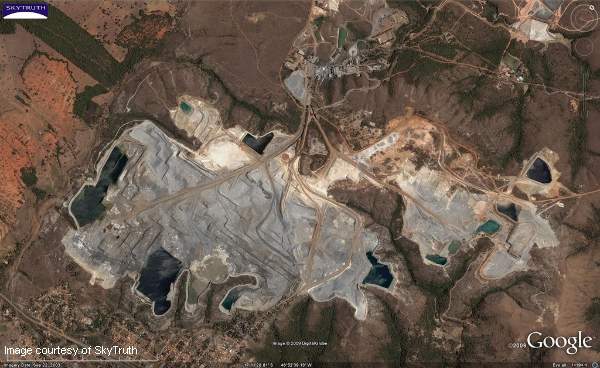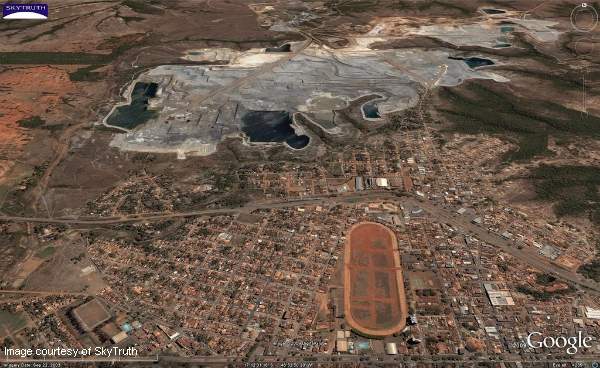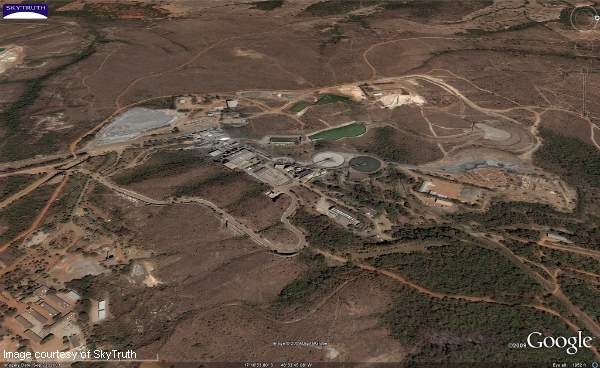The Paracatu gold mine is located in Brazil, north of Paracatu city and nearly 230km from the capital city of Brazil, Brasília. Operations at the open pit property began in 1987.
The mine is owned by Canada-based company Kinross Gold and is operated by Rio Paracatu Mineração (RPM), a 100% subsidiary of Kinross. The company first acquired 49% stake in the mine in 2003 with the merger of TVX Gold, another Canadian mining company.
Kinross became the sole owner of the mine in 2004 when it purchased the remaining 51% stake from Rio Tinto. The mine produced 500,380oz of gold in 2013.
Natural reserves at the Brazilian Paracatu gold mine
The combined proven and probable reserves as of 31 December 2013 were estimated to be 763 million tonnes (mt) graded at 0.42g/t Au. The measured and indicated resources were estimated to be 540mt graded at 0.36g/t Au.
Geology of Paracatu gold mine
The deposit is a metamorphic gold structure hosted within the lowermost section of the Upper Proterozoic Paracatu Formation, that is regionally known as the Morro do Ouro sequence.
The Morro do Ouro sequence is a complex of highly deformed phyllites.
Mineralisation and rock formations
Mineralisation is syn-deformational with the rock thrusting of the sequence from west-southwest to east-northeast and is restricted to the finely laminated phyllites.
A 120m to 140m thick, high strain zone with a gentle, southwest dip hosts the anamalous gold and sulphide mineralisation.
The strain zone extends more than 6km along a northeast-southwest trend.
Within the strain zone, ore grade varies according to geologic features, including boudins, extent of shearing and the content of arsenopyrite.
Mineralisation has been segmented into four horizons designated – C, T, B1 and B2 – based on the extent of oxidation and surface weathering and related sulphide mineralisation. Reserves are hosted in the B1 and B2 horizons, with the C and T horizon exhausted due to mining.
Gold is hosted as free gold or electrum with sulphide mineralisation.
Mining and processing carried out at the site
The deposit is mined using open pit methods. Historically, the mine did not require any blasting. It is usually ripped pushed and loaded on to the carriers. Blasting of the harder ore hosted in certain sections of the mine began in 2004.
The ore is broken using CAT D10 dozers and loaded using CAT 992 front-end loaders. The ore is delivered to the crusher in CAT 777 haul trucks.
Run-of-mine is transported by 240t capacity rear-dump haul trucks to the 480t crusher dump hopper.
Processing is carried out in a 61mtpa processing plant. The primary crusher is installed within the open pit. The ore is crushed to 25mm and the circuit ball mill grinds it to 80%. Sulphide and gravity concentrates are produced in the ball mills.
The concentrates are grinded again in the ball mills and leached in cyanide in the carbon-in-leach (CIL) plant. Dore bars of gold are produced from the metal recovered from the leached carbon.
Expansion of the Brazilian Paracatu gold mine
An expansion was undertaken in 2006 to increase the ore processing facilities at the mine from 18mtpa to 61mtpa. The expansion was necessitated after an exploration drilling found an increase in the mine reserves. The expansion is expected to extend the mine’s operations until 2042.
The new plant became operational in 2008. It includes a crusher, a 20MW semi-autogenous grinding (SAG) mill, two ball mills, a gravity plant, and a flotation plant.
The older plant processes soft B1 ore while the new plant processes both B1 and harder B2 ore. Both the plants were operating at a capacity of 20mtpa. An additional ball mill of 13MW became operational at the new plant in June 2011 increasing the new plant’s capacity to 41mtpa.
This processes the hard B2 ore. A fourth ball mill was also installed at the plant for increasing the productivity.
A single hydrometallurgical plant caters to both the plants. This was expanded in 2008 to cater to the increased processing capacity.
Contractors involved
Metso supplied the ball mill units for the Paracatu gold mine’s expansion.





